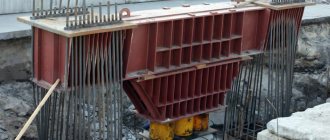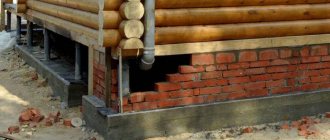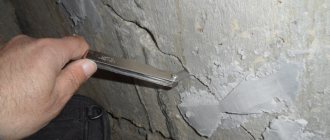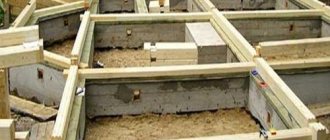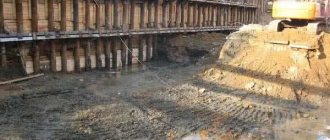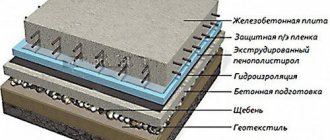The appearance of cracks in the walls and foundation during the operation of a building is a good reason for concern for the owner, making a decision to strengthen the foundation at the initial stages of the problem. One of the modern and effective ways to strengthen the foundation of a house is to strengthen the foundation by injecting special materials into the pores of concrete and soil.
Before taking decisive action to eliminate the problem, it is necessary to understand the reasons, know what methods exist to strengthen the foundation, what technology is suitable for a particular structure, and carry out economic calculations of the cost of work for various options.
Why are foundations collapsing?
The reasons for the destruction of the foundation are different. It is important to understand why the problem arose in order to take measures to eliminate it. Here are some reasons leading to structural failure:
- Initially incorrect calculation of the foundation without sufficiently complete hydrogeological and geological studies of soils at the design stage.
- Violation of technology when preparing the mixture for forming a tape leads to concrete with reduced strength, frost resistance, and water resistance. This affects the load-bearing capacity of concrete and service life.
- Redevelopment of a house with critical deviations from the project, addition of a floor, attic.
- Changes in soil conditions and groundwater levels during operation. This happens for natural reasons, the movement of layers during seismic vibrations, changes in the condition and moisture of soils when the groundwater level rises during the construction of a loaded object in the immediate vicinity.
- Violation of waterproofing.
Waterproofing by injection: details of technology
Moisture enters structures through pores or cracks. Filling such cavities with a special hydrophobic composition makes it possible to completely eliminate the migration of both the liquid itself and its vapors. There is no need to replace a damaged or insufficiently sealed area. Cavities, pores and cracks are covered with a plastic material that is resistant to static deformation and dynamic loads, which ultimately strengthens the wall or foundation itself.
The use of modern technologies allows us to avoid large-scale excavation work, which often requires the use of heavy equipment. In addition, such work implies high safety requirements, and their implementation is not always possible in large cities with dense buildings.
Materials used for injection waterproofing
The basis of any mixture is its active component. Today on the market there are compositions based on acrylate, epoxy resin, polyurethane and cement. Their main characteristics, depending on the active component:
- Acrylate. The mixture has low viscosity, effectively fills cracks and cavities, and polymerizes even in the presence of water. Suitable for veil waterproofing, when the waterproof layer of sealant is located at the border of the soil and the wall structure.
- Polyurethane. Composition of foamy consistency. Can be an effective solution for creating shut-off waterproofing when it is necessary to eliminate pressure leaks. Before injecting concrete, stone or brick walls with a polyurethane mixture, it is necessary to moisten the structures - this is an important condition for high-quality adhesion of the composition to the surface. A more environmentally friendly solution that operates on the same principle is the compositions “Kalmatron” and “Kolmatex”.
- Epoxy resin. A two-component mixture consisting of an active liquid and a catalyst. Can only be applied to dry surfaces. Despite the high adhesion rates, which exceed the strength of the treated mineral bases, the mixture has limitations in use due to the toxicity of its components.
- Hydroconcrete "Kalmatron". The mixtures contain components that, upon contact with moisture, turn into crystals that rapidly expand in the cavities of pores and cracks. These compositions are environmentally friendly and can be used to seal containers with drinking water.
Applied injection waterproofing technologies
To create a waterproof barrier, inclined channels are drilled into the thickness of the walls. Nozzles are inserted into them, to which a compressor unit is connected to supply liquid composition under pressure. Penetrating into the thickness of wall structures, the mixture fills the smallest pores, cracks and cavities. This creates a reliable barrier against moisture migrating into the room.
In cases of volumetric leaks, acrylic or polyurethane sealants are used, which are plastic and adhere well to moisture-saturated surfaces. If it is necessary to ensure high strength of the sealing zone, compositions based on cement or epoxy resins are used.
Choosing a foundation restoration method
The choice of method for restoring the bearing capacity of the foundation is determined based on the results of repeated geological and hydrogeological studies of soils, determining the strength characteristics of concrete at the time the problem occurred.
The best option is to contact an organization that specializes in such research, carrying out projects to restore foundations and strengthen soils. It is impossible to solve such a complex problem with your own hands. Experts will determine the degree of destruction and propose specific methods for restoring the bearing capacity of the foundation.
Sometimes the repair issue is resolved quickly, without much expense, using old methods of restoring the foundation:
- strengthening the foundation body with cages;
- increasing the area of the sole;
- reinforcement piles;
- increasing the laying depth with the installation of an additional foundation or monolithic slab.
In modern thinking, strengthening the foundation for a building is represented as:
- Strengthening the body of the structure itself.
- Strengthening foundation soils in order to increase bearing capacity with changes in physical properties.
Strengthening the strength of the foundation body
When determining certain works to strengthen the foundation, it is often enough to increase the strength of the structure body, which has lost its design characteristics. To restore the quality, strength, and water resistance of concrete, microcementing technology is used.
Microcement is a mineral binder of particularly fine grinding, produced by the air segregation method, and has a smooth gradation of granulometric composition.
Injection of microcement into the concrete body until cracks emerge
The technology consists of injecting an aqueous suspension of microcement into the body of the structure being strengthened under a pressure of 10-30 bar. Here are some steps in the injection process:
- Holes with a depth of 2/3 of the structure are drilled in the body of the concrete at an angle, not reaching 40-50 centimeters to the base of the base. Holes are made every 50-60 centimeters along the perimeter of the foundation.
- Cuff strings or packers are installed.
- An aqueous suspension of microcement is prepared using a special high-speed mixer (>2000 rpm). The water-cement ratio is assumed to be within 0.7-1.2.
- The suspension is pumped through cuffs, packers with a screw or plunger pump until the solution comes out from the back side or a “stop” is obtained when the pressure increases >30 bar.
- The suspension penetrates into concrete pores, shells, hairline and shrinkage cracks. The pressure in the system is released, the packer remains, maintaining residual pressure in the body of the structure.
In addition to microcement emulsion, the following are used for injection: liquid glass, polymer-based compositions.
Injection waterproofing of the basement from the inside
Groundwater often washes away the soil. Basement waterproofing is always best done from the outside, not the inside, so that it works by pressing, not by pulling. This is a great protection against groundwater. But there are situations when there is no access to the basement from the outside, since the house or building has already been built and in order to get to the walls of the lower room or foundation you need to dig out the building or house from the outside, which is not always possible. In this case, waterproofing is done from the inside. Protection from groundwater from inside the basement is mainly carried out by injection waterproofing, by injecting special polyurethane mixtures into the concrete body, seams and cracks, depending on where leaks are observed. There are different materials for waterproofing, their choice depends on the type of leakage, the material from which the foundation is made and the main supporting structures of the basement. The most popular injection mixtures are helium compounds (mainly intended for brick walls) and polyurethane compounds (mainly intended for walls made of concrete, aerated concrete, etc....).
Injection waterproofing with polyurethane
Polyurethane injection includes injection into leaking seams, cracks, problem areas of the floor and foundation walls. This type of repair is most suitable for monolithic concrete slabs and concrete blocks of various types; most basements are built from these 2 materials. This injection is very reliable against groundwater, and provides long-lasting protection when the composition is correctly introduced by a professional waterproofing specialist from the inside. For durability and reliability, the injection polyurethane composition itself is also important. Here, expensive imported materials produced by BASF or, more optimally priced, the HydroInject line of polyurethanes from Hydro are best suited.
Strengthening the foundation and soils
When the inspection of the foundation reveals the need to strengthen its load-bearing capacity, silicatization technologies, soil cementation, a “wall-in-wall” soil separation device, and installation of drilled injection piles through the body of the structure are used.
The technological process of installing drilled injection piles is divided into the following stages:
- A hole larger than the diameter of the installation auger is drilled in the body of the foundation at an angle, up to the base pad. A sleeve is mounted, which will serve as a guide conductor.
- A hollow auger is used to drill a hole in the ground to the design mark, and the remaining soil is removed from the hole with air.
- A concrete mixture is prepared and pumped into the well under a pressure of 1.5-5 bar until a clean mixture comes to the surface. In this case, the injection volume must exceed 2 well volumes and enter the soil through pores.
- A metal frame is installed into a well filled with cement mixture so that a protective layer of concrete remains around it.
- In case of problematic soils or the passage of groundwater, a casing string made of a metal pipe is installed during drilling.
The use of drilled injection piles ensures the preservation of the natural state of the soil in neighboring areas and does not affect the condition of the building being repaired or surrounding buildings.
Installation procedure for drilled injection piles
Methods of strengthening the soil under the foundation, improving its physical characteristics, increasing the bearing capacity are carried out by injection:
- Resins - Sika Injection 201, 451; Sikadur 52, 53; MC Inject 2300 Plus; Manopur 143. Acrelate elastic gels - Sika Injection 304/305, MC Inject GL 95 DX.
- Injection microcement suspension SikaRock Fill 10.
- Cement mortar with expanding binder
- Two-component polyurethane resin Bast Meyco 355 A 3 Tix.
Soil strengthening using injection methods
These methods make it possible to create zones in the soil under the foundation with improved physical characteristics in terms of bearing capacity.
Video: Strengthening foundations
Installation of drilled injection piles
What is a drilled injection pile, and how is it constructed? This is a concrete structure that is installed at an angle of 300-450 to the foundation walls so that it takes on the load-bearing loads from the local area being repaired (builders say it unloads). The technology for repairing the foundation using drilled injection piles is technically simple, except for one point: it is almost impossible to install them yourself and without special equipment.
The pile is made of concrete with fine fillers and is not reinforced, but any foundation can be strengthened in this way. Concrete in this technology is used everywhere - both when creating a pile, and when pouring it, and when carrying out injections, so the main disadvantage of this method is the high cost associated not only with the preparation of a large volume of solution, but also with its delivery. Wells for installing piles may require from several units to several dozen, and with a minimum well diameter of 30 cm and a support depth of up to several meters, an impressive mixture consumption figure will be obtained. In practice, the depth of the pile depends on the level of soil freezing, and you need to drill 0.5-0.7 m below this point.
Important: Only immersion of the piles below the freezing level will help maintain the strength of the structure, which can withstand the load-bearing loads from the object being repaired, since the piles act as the main reinforcing element of the reinforced foundation.
Construction and installation of drilled injection piles
Advantages of drilled injection piles for strengthening and repairing foundations:
- Piles can be mounted in places that are difficult to reach for construction equipment;
- You can even strengthen the foundations of buildings located in areas of strong industrial vibrations:
- When using natural wild stone, the result is not the strongest foundation, which can move sideways over time, but the use of drilled injection piles strengthens even such old structures;
- Professional pile design uses classical techniques to determine the number of supports and type of structure;
- Bored injection piles have an ideal load-bearing capacity, which allows them to withstand the weight of any building standing on loose or sandy soil, since the well is drilled below the level of weak soil layers.
Special equipment for installing piles
It is recommended to strengthen the foundation in the following cases:
- Cracks began to appear in the foundation;
- Local shrinkage of the building occurs. This can manifest itself both in the corners and along the perimeter of the walls of the house;
- When restoring a dilapidated building, the current condition of which must be preserved before the start of repairs;
- If it is necessary to protect the foundation from industrial or industrial vibrations. As an example, ground vibrations in the area of railway junctions or large highways;
- If it is necessary to replace a damaged screw pile or columnar support, a bored pile can be used;
- When strengthening a building in a densely built-up area - in the city center, for example.
Installation of a pile inside a building
Sequence of work operations to strengthen foundations using drilled injection pile supports:
- Before drawing up a project for the foundation to be repaired, a calculation of the new structure is made, after which the project itself is developed;
- Through surveys, the type and properties of the soil, the number of layers and the depth of the durable layer are established;
- According to the markings in the project, wells are drilled - the drilling angle is 300 from the vertical axis, the depth is calculated;
- Concrete mortar for injection should be of medium density with low dispersion;
- Using special equipment or a powerful pump that creates the necessary pressure, the concrete solution is pumped into the well;
- The wells are connected by reinforcement to each other and to the foundation being repaired.
Creation and pouring of drilled injection piles

